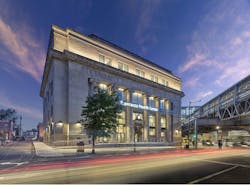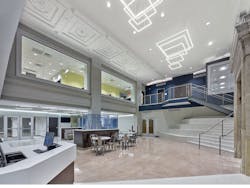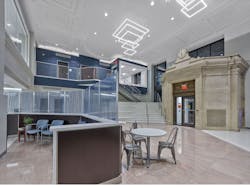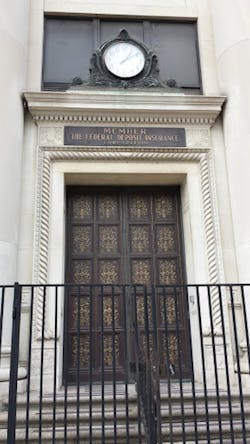Can converting a landmark office to a clinic raise up a downtrodden Philadelphia neighborhood?
The 92-year-old Kensington Trust Company Building in Philadelphia is a community landmark. But in recent years, this limestone edifice—vacant since 2015, after its last tenant, Wells Fargo, left—had come to symbolize a poor and crime-ridden neighborhood’s despair. The intersection of Kensington and Allegheny Avenues, where the building sits, has been ground zero for the city’s devastating opioid epidemic.
Kensington Trust’s restoration and adaptive reuse as the Esperanza Health Center—which received an Honorable Mention Reconstruction Award from BD+C—aspired to elevate the location as a catalyst for community engagement. Esperanza’s myriad services include primary medical care for adults and children, dental care, prenatal care, behavioral health, on-site medication dispensaries, and social services assistance.
There’s even a bank branch that provides support and instruction to assist residents who are unfamiliar with financial practices.
This project's site plan shows some of the features that were added, as well as the building's proximity to mass transit and Philadelphia's city center.
Accessibility is key. The building is adjacent to a stop on the city’s Market-Frankfort subway line. The building’s front steps, which had been closed off to pedestrians and visitors, now provide a ground-floor terrace leading to a café and seating area that are open to the public.
“Esperanza Health Center serves as a beacon of hope for a blighted community that feels it has been forgotten,” stated Brawer & Hauptman Architects, which submitted this project for award consideration. “This health center … demonstrates how preservation and adaptive reuse of a neighborhood’s architectural assets can build community and uplift its residents,”
The owner organization is a multicultural faith-based ministry that provides affordable, holistic healthcare to Latino and underserved communities in North Philadelphia. The Kensington Trust building is now its flagship location.
A BUILDING FOR ALL OF THE COMMUNITY
The vision for this project was to create a light-filled, transparent, and welcoming facility. A key design criterion was for informal gathering spaces that could be used by the community. And bringing back the grandeur of the lobby’s space was the focus of the project. Modern architectural materials and light fixtures were chosen to accent existing historical detail. For example, pendant lights resemble the coffers in the plaster ceiling, and draw attention to the height of the atrium.
The building's atrium, seen from two perspectives, shows how the new and old intersect: the original building's marble floors and vertibule were retained, while features like pendant lighting were added. Waiting rooms overlook the atrium.
Connecting the clinical and public components of the building was important for community awareness. The dental waiting area has framed views of the atrium below and the street. Even the exam room has a view of the elevated subway platform outside. Patients in exam rooms can see the elevated subway platforms.
Many of the building’s original architectural elements—such as its plaster ceilings, marble floors and vestibule, and brass entrance doors—were preserved. Two large clocks at the building’s entrance, which hadn’t operated for decades, were restored to working order. The bank’s main vault, lined with brass safety deposit boxes and retaining its massive vault door, now serves as a staff lounge. A second vault on the ground floor became the facility’s chapel.
To guide the clinic’s many patients for whom English is a second language, the building’s wings are color coded for easier wayfinding.
Among this project's design criteria was connecting the community to the clinic. A dental waiting room (above) looks out onto the building's atrium and the street. An exam room (below) offers views of a nearby elevated subway platform.
STEMMING GROUNDWATER AND GRAFFITI
Demolition of existing interior partitions and ceilings on the upper floors found concrete-encased steel on the bottom of the floor slabs. The redesign strove to exploit these elements and highlight the existing structure. However, having open ceilings in the corridors and public spaces of the upper clinical floors, while aesthetically pleasing, made new installations like electricals and ducts more challenging.
During the project’s investigative stage, it was also discovered that the building had been constructed over an active creek called Gunner’s Run that ran through an area toward the Delaware River. The building sits at the lowest point in the watershed, and that creek recharges after several days of rainfall. Consequently, controlling groundwater intrusion required extensive interior trenching and waterproofing.
Before its reconstruction, wrought iron fencing blocked visitors from entering the Kensington Trust building. Now the entrance terrace leads to the clinic's cafe and seating area. The brass doors were preserved.
Above ground, the building had long been a tagging canvas for graffiti artists, with an estimated 60 layers of paint on certain areas of its exterior surface. A city agency, Community Life Improvement Program (CLIP), was charged with removing the graffiti as part of the effort to return the building’s stone surface to its natural beauty.
Kensington Trust’s monumental windows were replaced, its limestone cleaned, and exterior lighting installed to make its presence in the community even more prominent. The entrance to Esperanza Health Center was made fully accessible, and greets its visitors and patients with an engraved message that reads “To the glory of God for the people of Kensington.”
PROJECT INFORMATION: Size 35,000 sf Construction start and finish Dec. 1, 2018 – July 1, 2019 Cost $12.5. million Delivery method Design-bid-build
BUILDING TEAM: Submitting firm and Architect Brawer & Hauptman Architects Owner/developer Esperanza Health Center SE Orndorf & Associates ME/PE Smith Miller Associates GC Target Building Construction CM Omnivest






